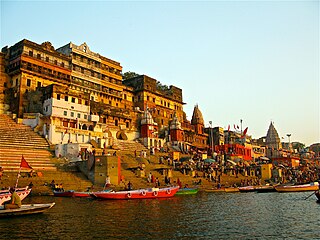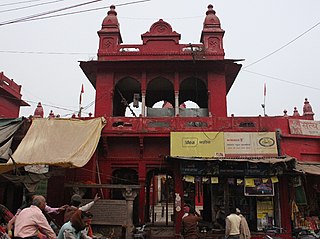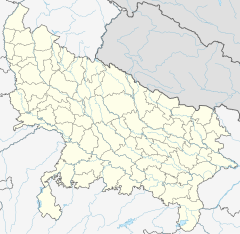
The Kashi Vishwanath Temple is a famous Hindu temple dedicated to Lord Shiva. It is located in Vishwanath Gali of Varanasi, Uttar Pradesh in India. The temple stands on the western bank of the holy river Ganga, and is one of the twelve Jyotirlingas, the holiest of Shiva temples. The main deity is known by the names Shri Vishwanath and Vishweshwara literally meaning Lord of the Universe. Varanasi was called Kashi ("shining") in ancient times, and hence the temple is popularly called Kashi Vishwanath Temple.

Benares or Banaras State was a kingdom and later princely state in what is today Uttar Pradesh, India. On 15 October 1948, Benares' last ruler signed the accession to the Indian Union.

The Vishalakshi Temple or Vishalakshi Gauri Temple is a Hindu temple dedicated to the goddess Vishalakshi, at Mir Ghat on the banks of the Ganges at Varanasi in Uttar Pradesh, India. It is generally regarded as a Shakti Pitha, the most sacred temples dedicated to the Hindu Divine Mother.
Ramnagar is a city and a municipal board in Varanasi district in the Indian state of Uttar Pradesh. Ramnagar has a fort known as Ramnagar Fort which is still the residence of King of Varanasi (Benares). He was known as Kashi Naresh meaning king of Kashi and is still regarded by old residents of the city of Varanasi. Ramnagar Fort and its museum are the repository of the history of the kings of Benares and since the 18th century has been the home of Kashi Naresh. Even today the Kashi Naresh is deeply revered by the people of Benares. He is the religious head and the people of Benares consider him the incarnation of Shiva. He is also the chief cultural patron and an essential part of all religious celebrations. Ramnagar is popular for Ramlila that is held annually under the aegis of King of Varanasi
Bhabhanpura is a village on the outskirts of Varanasi city, located 7 km away from the heart of the city. Total population of the village is 2,992.

The Narayan dynasty was the ruling family of Benares. After its liberation from Awadh, independence (swaraj) was established in Benares by Maharaja Balwant Narayan Singh in the 18th century. Since then, the family has ruled Benares. In 1911, Benares became a full-fledged princely state of British India and the Narayan dynasty ruled it as British vassals until they acceded to independent India in 1947.

The Ramnagar Fort is a fortification in Ramnagar, Varanasi, India. It is located near the Ganges on its eastern bank, opposite to the Tulsi Ghat. The sandstone structure was built in the Mughal style in 1750 by Kashi Naresh Maharaja Balwant Singh. At present, the fort is not in a good shape. The current king and the resident of the fort is Anant Narayan Singh, who is also known as the Maharaja of Benares even though this royal title has been abolished since 1971.

Varanasi Junction railway station, also known as Varanasi Cantt railway station, is the main railway station serving the city of Varanasi. The other key railway stations in Varanasi Metro area are Banaras, Varanasi City, Pt. Deen Dayal Upadhyay Jn. and Kashi. The junction station is sandwiched between the cantonment region and Chetganj region of the city. The station is partially controlled by the Lucknow Division of the Northern Railway Zone and the Varanasi Division of the North Eastern Railway Zone of the Indian Railways. Varanasi Junction railway station nearly reaches the frequency of 300 trains daily. Almost, 45 trains originate and terminate at the station. Premium trains of Indian Railways also originate from Varanasi Junction, such as Vande Bharat Express and Mahamana Express

Ghats in Varanasi are riverfront steps leading to the banks of the River Ganges. The city has 88 ghats. Most of the ghats are bathing and puja ceremony ghats, while two ghats, Manikarnika and Harishchandra, are used exclusively as cremation sites.

The Gyanvapi Mosque is located in Varanasi, Uttar Pradesh, India. It was constructed on the site of an older temple of Vishweshwar, which had been demolished by the Mughal Emperor Aurangzeb in 1669.

The Chunar Fort is located in Mirzapur district of Uttar Pradesh, in India. Along with Chunar town, situated below the fort, the two are historic places with common history and legends. It is located 23 kilometres (14 mi) south west of Varanasi. The southeastern part of the fort is on the rocky bank of the Ganges River. The fort's history spans from 56 BC and then between Afghan decedent Sher Shah Suri's (1532) rule, the Mughal Empire rule up to 1772, and Marathas in 1782 to 1804. Lastly, the British Raj occupied the fort to 1947 when India gained independence. Chunar railway station is on the Pt. Deen Dayal Upadhyaya–Kanpur section of Howrah–Delhi main line.

Varanasi is a city on the Ganges river in northern India that has a central place in pilgrimage, death, and mourning in the Hindu world. The name Varanasi was officially so revived after 1947, but the city is still widely known as Banaras or Benares, and since ancient times also as Kashi. The city has a syncretic tradition of Muslim artisanship that underpins its tourism. Located in the middle-Ganges valley in the southeastern part of the state of Uttar Pradesh, Varanasi lies on the left bank of the river. It is 692 kilometres (430 mi) to the southeast of India's capital New Delhi, 320 kilometres (200 mi) south-east of the state capital, Lucknow, and 121 kilometres (75 mi) east of Allahabad, another Hindu pilgrimage site.

Bhelupur is a suburban neighbourhood located in south of Varanasi district. It is situated 2.5 kilometres west of Kedar ghat and to the river Ganges. Benaras Hindu University is situated 4.5 kilometres south of Bhelupur.

Durga Mandir, also known as Durga Kund Mandir and Durga Temple, is one of the most famous temples in the holy city of Varanasi. This temple has great religious importance in Hinduism and is dedicated to the Maa Durga. Durga Mandir was constructed in 18th century by Rani Bhabani of Natore.

Bharat Mata Mandir is located on the Mahatma Gandhi Kashi Vidyapith campus in Varanasi,Uttar Pradesh, India. Instead of traditional statues of gods and goddesses, this temple has a huge map of undivided India carved in marble. This temple is dedicated to Bharat Mata and claims to be the only one of its kind in the world.

Shri Vishwanath Mandir also known as Vishwanath Mandir, Vishwanath Temple (VT), New Vishwanath Temple and Birla Temple is one of the most famous temples and biggest tourist attractions in the Hindu holy city of Varanasi. The temple is situated in Banaras Hindu University and is dedicated to the Lord Shiva. Shri Vishwanath Mandir has the tallest temple tower in the world with the Shikhara's height being around 250 feet. The temple is colloquially called VT, an acronym of Vishwanath Temple.

Ratneshwar Mahadev Mandir is one of the most photographed temples in the holy city of Varanasi in Uttar Pradesh, India. The temple, while apparently well-preserved, leans significantly towards the back side (north-west), and its garbhagriha is generally below the water much of the year, except for a few months during the summer. The Ratneshwar Mahadev Temple is situated at Manikarnika Ghat, Varanasi. The temple has developed a nine-degree slant.

Rafa'at wa Awal-i-Martabat Maharaja Sri Chait Singh Sahib Bahadur, commonly known as Chait Singh, was a ruler of Kingdom of Benares in northern India. He belonged to the Narayan dynasty of Bhumihar Brahmins




























